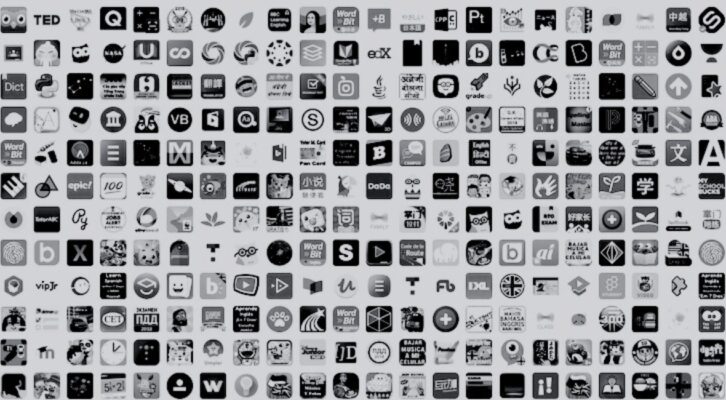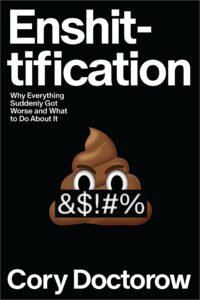
How American Tech Cartels Use Apps to Break the Law
Cory Doctorow on Big Tech’s Drive to Enshittify Our Lives
The death of competition spells doom for regulation. Competition is an essential component of effective regulation, for two reasons: First, competition keeps the companies within a sector from all telling the same lie to its regulators. Second, competition erodes companies’ profits and thus starves them of the capital they need to overpower or outmaneuver their regulators.
While not all regulation is wise or helpful, a world without regulation is a catastrophe. That’s because, in a highly technological world, your ability to do well (or even to live out the day) requires that you correctly navigate innumerable highly technical questions that you can’t possibly answer.
You need to know whether you can trust the software in your car’s antilock braking system, whether you should heed your doctor’s advice to get vaccinated, whether the joists over your head at home are sufficient to keep the ceiling from falling in and killing you, and whether your kids’ schooling is adequate or likely to turn them into ignoramuses.
Tech-like apps can obfuscate what’s really going on, sloshing a coat of complexity over a business that allows its owners to claim that they’re not breaking the law.
It’s not that you lack the intellect and discernment to answer each of these questions. You’re a smart cookie. Given enough time, you could get a PhD’s worth of education in software engineering, cell biology, material science, structural engineering, and pedagogy; investigate each of the offerings before you in each of these categories; and make an intelligent choice that reflects your priorities and the trade-offs you’re willing to make.
The problem is that it would take you several lifetimes to acquire all that knowledge, and long before you could do so, you’d be killed by food poisoning because you guessed wrong about whether you could trust the hygiene policies at your local diner.
It would be nice if you could let markets take care of these questions for you, but many of the consequences of wrong answers don’t manifest fast enough to steer your decision-making. Sure, if a private school turns one of your kids into an ignoramus, you can demand your money back and refuse to send your other kids to that school—but your kid is still an ignoramus. Likewise, you can punish a restaurant that gives you food poisoning by withholding your future custom, but if that’s a lethal poisoning, the fact that you don’t eat at that restaurant anymore isn’t quite the moral victory you might be hoping for.
To navigate all of these technical minefields, you need the help of a third party. In a modern society, that third party is an expert regulator who investigates or anticipates problems in their area of expertise and then makes rules designed to solve these problems.
To make these rules, the regulator convenes a truth-seeking exercise, in which all affected parties submit evidence about what the best rule should be and then get a chance to read what everyone else wrote and rebut their claims. Sometimes, there are in-person hearings, or successive rounds of comment and counter-comment, but that’s the basic shape of things.
Once all the evidence is in, the regulator—who is a neutral expert, required to recuse themselves if they have conflicts—makes a rule, citing the evidence on which the rule is based. This whole system is backstopped by courts, which can order the process to begin anew if the new rule isn’t supported by the evidence created while the regulator was developing the record.
This kind of adversarial process—something between a court case and scientific peer review—has a good track record of producing high-quality regulations. You can thank a process like this for the fact that you weren’t killed today by critters in your tap water or a high-voltage shock from one of your home’s electrical outlets.
One key advantage of the process is that it relies on competitors to counter one another’s claims. The reinforced steel joist manufacturer that claims that only its products are suitable for use in high-rise apartment buildings will have to defend those claims against competitors who submit their own structural engineering and material science evidence. Regulators don’t need to look for holes in the arguments advanced by interested parties; they only need to assess the quality of the criticisms raised by other commenters who submit to the docket.
This process isn’t just a way to prevent corporate executives from cheating the public by knowingly overpromising about their own products or denigrating their rivals’; it’s also a way to stop firms that have tricked themselves from fooling the rest of us, too. As with the scientific method, the safeguards of peer review help us catch grubby attempts at both deception and self-deception, because it’s very easy to talk yourself into a sincere belief that you are right and everyone else is wrong.
This process works well on “disorganized” sectors composed of many firms that compete hard with one another. When hundreds of companies are all at one another’s throats, they suffer from a collective action problem—the same force that keeps users from leaving services like Facebook.
Hundreds of companies find it impossible to agree on almost anything, including where to have a meeting in which they could discuss what line they are going to feed their regulator. They probably can’t even agree on how to cater that meeting.
Hundreds of companies are a disorganized rabble. They can’t come to accord, and even if they could, a truly competitive sector produces smaller profits for each company (since one of the best ways to compete is by lowering prices to attract new customers and raising wages to attract the best workers). That leaves very little surplus capital with which to pursue regulatory adventures.
But when a sector dwindles to five companies—or four, or three, or two, or just one—the collective action problem is annihilated by the inevitable coziness among the executives of the incestuous industries.
After all, the executives in an industry dominated by a handful of firms are apt to have worked at most or all of the companies in the sector. They know one another, came up together, and are part of one another’s social milieu.
Not only do concentrated industries find it easier to converge on a set of policy priorities and maintain message discipline while bargaining with their regulators, they also have a lot to bargain with. Concentrated sectors tend to have Mafia-style demarcations of turf. (Think of Pope Alexander VI dividing up the “New World” in 1494, of cable companies carving up the map of the United States into exclusive fiefdoms, or of Apple taking an annual $20 billion-plus payment from Google in exchange for not making its own search engine.)
This prevents “wasteful competition” and allows these companies to amass gigantic war chests that they can mobilize to win their policy priorities.
A hundred companies are a mob, a rabble. Five companies are a cartel.
“Regulatory capture”—when a company suborns its regulator and teams up with it to screw over customers, rivals, and suppliers—starts with a regulator that is weaker than the company it is supposed to be watchdogging. The pro-monopoly policies of the past forty years have produced gigantic companies that find it easy to unite against their regulators, even as the deregulatory policies over the same period have starved regulators of the resources they need to fight back. The inevitable result is regulatory capture.
*
Regulatory capture has two faces: On the one hand, a captured industry is able to flout regulations that are meant to prevent it from harming the public, its employees and other stakeholders, and the environment. On the other hand, regulatory capture creates a coalition between the regulated industry and its regulators. They form a team and work together to enforce rules against other industries, startups, foreign adversaries, and so on. Regulatory capture isn’t the same as underregulation; rather, it is the combination of underregulation (for the industry that has effected the capture) and overregulation (against that industry’s enemies).
Tech companies don’t stop with “It’s not a crime if we do it with an app.” They also say, “It’s a crime if you fix our app to defend yourself from our crimes.”
The most common tactic used to flout regulation is to break the law with an app and then insist that the law hasn’t been broken at all, because the crime was committed with an app.
Sometimes literally (as Uber does when it argues that it’s not an employer because it directs its workers with an app) and sometimes figuratively. Tech-like apps can obfuscate what’s really going on, sloshing a coat of complexity over a business that allows its owners to claim that they’re not breaking the law. (“It’s not an illegal unregulated hotel, it’s an Airbnb!”)
Riley Quinn, showrunner for the excellent Trashfuture podcast, says that whenever you hear the word fintech (financial technology), you should mentally substitute unregulated bank.
App-based lending platforms ignore usury law and say it doesn’t count because they do it with an app. Cryptocurrency hustlers illegally trade in unregistered securities and say it doesn’t count because they do it with an app.
When Uber entered the taxi market without securing taxi licenses or extending the workforce protections required under law, it said the move didn’t count because it did it with an app.
The McDonald’s-backed company Plexure sells surveillance data on you to vendors, who use it to raise the price of items when they think you’ll pay more. In its promotional materials, Plexure uses the example of charging extra for your breakfast sandwich on payday. It says that such practices are not a rip-off because they’re done with an app.
RealPage gives “recommendations” to landlords about the minimum rents they should charge for all the apartments in your neighborhood, raising rents and worsening the housing crisis. The company says it’s not price-fixing because it’s done with an app.
On the subject of the housing crisis, Airbnb is racing to convert all the rental stock in your city into an unlicensed hotel room, but it says the conversion doesn’t count because it’s done with an app.
The legal regime for apps really is different from the rules governing web pages. Thanks to intellectual property laws that ban “circumvention,” companies that embed undesirable anti-features in apps can use the law to destroy rivals that disenshittify their offerings.
In other words, tech companies don’t stop with “It’s not a crime if we do it with an app.” They also say, “It’s a crime if you fix our app to defend yourself from our crimes.”
__________________________________

Excerpted from Enshittification: Why Everything Suddenly Got Worse and What to Do About It by Cory Doctorow. Copyright © 2025 by Cory Doctorow. Published by Farrar, Straus and Giroux, October 2025. All rights reserved.
Cory Doctorow
Cory Doctorow is a science fiction author, activist and journalist. He is the author of many books, including The Lost Cause, a solarpunk science-fiction novel of hope amidst the climate emergency. His nonfiction book The Internet Con: How to Seize the Means of Computation is a Big Tech disassembly manual. Other recent books include Red Team Blues, a science fiction crime thriller; Chokepoint Capitalism, nonfiction about monopoly and creative labor markets; the Little Brother series for young adults; In Real Life, a graphic novel; and the picture book Poesy the Monster Slayer. In 2020, he was inducted into the Canadian Science Fiction and Fantasy Hall of Fame.



















